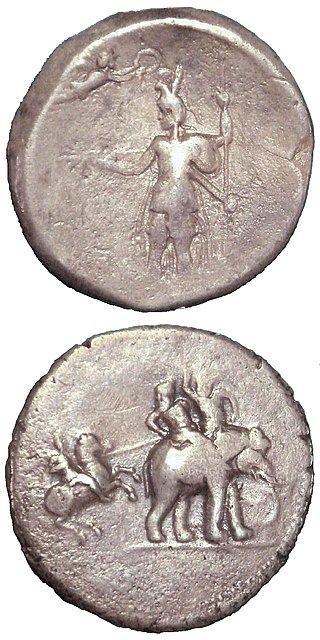
The 4th century BC started the first day of 400 BC and ended the last day of 301 BC. It is considered part of the Classical era, epoch, or historical period.

Chandragupta Maurya was the founder of the Maurya Empire, based in Magadha.

According to legendary narratives, preserved in various traditions dating from the 4th to 11th century CE, Chanakya was a Brahmin who assisted the first Mauryan emperor Chandragupta in his rise to power and the establishment of the Maurya Empire. According to these narratives, Chanakya served as the chief advisor and Prime Minister of the both emperors Chandragupta Maurya and his son Bindusara.

Bindusara was the second Mauryan emperor of Magadha in Ancient India. The ancient Greco-Roman writers called him Amitrochates, a name likely derived from his Sanskrit title Amitraghāta.

In ancient times, trade between the Indian subcontinent and Greece flourished with silk, spices and gold being traded. The Greeks invaded South Asia several times, starting with the conquest of Alexander the Great and later with the Indo-Greek Kingdom.

The Nanda dynasty was a ruling dynasty of Magadha that ruled an empire in north-east ancient India and Bengal during the fourth century BCE and possibly also during the fifth. The Nandas overthrew the Shaishunaga dynasty and expanded the empire to include a larger part of north-eastern India. Ancient sources differ considerably regarding the names of the Nanda kings and the duration of their rule, but based on the Buddhist tradition recorded in the Mahāvaṃsa, they appear to have ruled during c. 345–322 BCE, although some theories date the start of their rule to the fifth century BCE.

Dhana Nanda, according to the Buddhist text Mahabodhivamsa, was the last Nanda king of Magadha.

Mahapadma Nanda, according to the Puranas, was the first Nanda king of Magadha.

Chanakya is a 47-part drama epic Indian television historical drama written and directed by Dr. Chandraprakash Dwivedi that was originally telecasted on DD National from 8 September 1991 to 9 August 1992. Produced by Prakash Dwivedi, the series is a fictionalized account of the life and times of 4th century BCE Indian economist, strategist and political theorist Chanakya and is based on events occurring between 340 BCE and 321/20 BCE, starting with Chanakya's boyhood and culminating in the coronation of Chandragupta Maurya. Chandraprakash Dwivedi played the title role of Chanakya.

Chandragupta is a board wargame designed by Stephen R. Welch and released in 2008 by GMT Games as part of the Great Battles of History (GBoH) series of games on ancient warfare. Chandragupta simulates battles fought by the Mauryan Dynasty in ancient India, and in so doing, attempts to illuminate the features, challenges, and unique attributes of the Indian military system and culture during this period.

The Nanda–Mauryan War was a war fought in ancient India from c. 323 BCE to 321 BCE between the King Dhana Nanda of the Nanda dynasty and forces of Chandragupta Maurya that led to the establishment of the Maurya Empire in Magadha. Little is known from historical sources for certain dating about the conflict. According to Mudrarakshasa legends, Chandragupta's army included Bahlika, Kirata, Parasika, Kamboja, Saka, and Greek mercenaries. The army invaded capital city Pataliputra (Kusumapura) after regaining power and defeated the Nandas.

Chanakya Chandragupta is a 1977 Indian Telugu-language historical drama film directed and produced by N. T. Rama Rao under the banner of Ramakrishna Cine Studios. The film stars Akkineni Nageswara Rao, Rama Rao, Sivaji Ganesan, Jayaprada, Manjula and Kaikala Satyanarayana, with music composed by Pendyala Nageswara Rao.

Chandragupta Maurya is an Indian Historical drama series based on the life of Chandragupta Maurya, an Indian emperor of ancient India and the founder of the Mauryan Empire. Chandragupta Maurya was first aired in March 2011 on Imagine TV. Ashish Sharma played the adult and Rushiraj Pawar played the young Chandragupta Maurya.
Chandragupta is the last history play by Dwijendralal Ray, written in 1911. The play, set in ancient kingdom of Magadha, recounts how Chandragupta Maurya, with the help of his faithful minister Chanakya, ascended the throne of Magadha by defeating and subsequently killing his half-brother Nanda. It is one of the most popular plays by Ray. The story of the play is loosely borrowed from the Puranas and the Greek history.
Durdhara was the empress of Chandragupta Maurya, the founder of the 4th-century BCE Maurya Empire of ancient India, according to the 12th century CE Jain text Parishishtaparvan by Hemachandra. She is stated by this text to be the mother of the second Mauryan emperor, Bindusara also known as Amitraghāta.

Chakravartin Ashoka Samrat is a 2015 Indian historical drama TV series that aired on Colors TV from 2 February 2015 to 7 October 2016. with Siddharth Nigam portraying the young version of the character.

Chandra Nandini is an Indian Hindi-language historical drama television series that aired on StarPlus from 10 October 2016 until 10 November 2017. It was produced by Ekta Kapoor under her banner Balaji Telefilms and directed by Ranjan Kumar Singh. Starring Rajat Tokas as Chandragupta Maurya and Shweta Basu Prasad as a princess Nandni, the story is loosely based on the life of Chandragupta Maurya.

Porus is a historical drama television series based on the Battle of the Hydaspes, visualizing the lives of Porus, ruler of the Paurava Kingdom in India, and Alexander the Great, the king of Macedonia. It aired from 27 November 2017 till 13 November 2018 on Sony Entertainment Television. Another historical drama, Chandragupta Maurya, replaced it.
Rakshasa is a character in the ancient Indian Sanskrit-language play Mudrarakshasa. In the play, he holds the post of Amatya in the Nanda and Maurya courts of Magadha. Originally a minister of the Nanda king, he escapes during Chandragupta Maurya's conquest of the Nanda empire. He then makes several attempts to overthrow Chandragupta, but each time, he is outsmarted by Chandragupta's advisor Chanakya. Finally, he agrees to give up the resistance, and accepts the post of amatya in the Maurya court.














